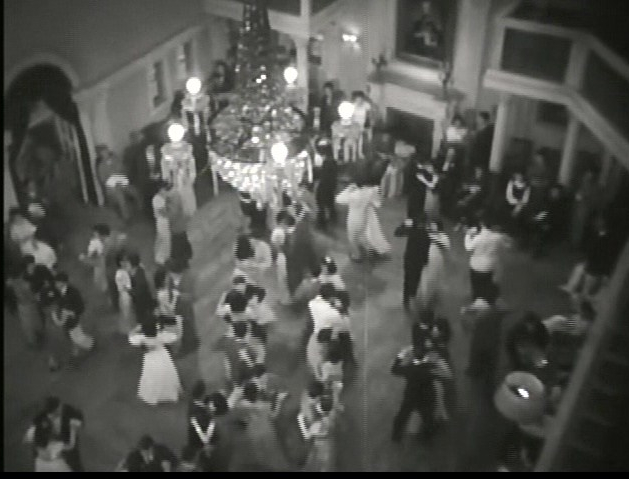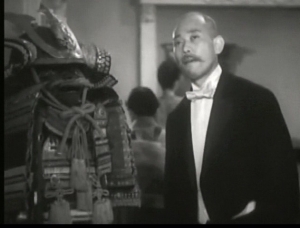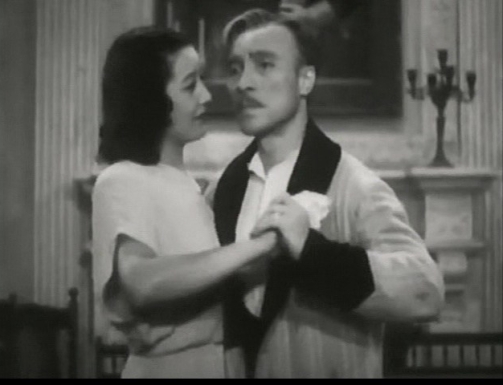 Bankrupted by the land reforms and new taxes of the Occupation era, a formerly wealthy family decide to hold one last ball in their home before they lose it. Echoes of Chekhov, particularly of The Cherry Orchard, run through everything we see. Though I think it would be unfair to call it a direct adaptation, there can be little doubt Chekhov was the model. Kaneto Shindo’s script seems to have found the parallels in post-war Japan to the collapsing world of the great Russian landowners that Chekhov personalized in his dramas.
Bankrupted by the land reforms and new taxes of the Occupation era, a formerly wealthy family decide to hold one last ball in their home before they lose it. Echoes of Chekhov, particularly of The Cherry Orchard, run through everything we see. Though I think it would be unfair to call it a direct adaptation, there can be little doubt Chekhov was the model. Kaneto Shindo’s script seems to have found the parallels in post-war Japan to the collapsing world of the great Russian landowners that Chekhov personalized in his dramas.
We are not particularly aided by the subtitles that convert all relationships into British social terminology, calling them a noble family and giving the father the title of Earl, so we don’t know precisely where in the pre-war social structure the family belonged. But we do see the honored suit of Samurai armor, we know that the dead Grandfather in the portrait over the mantelpiece was a general or admiral, and we are told that the family at one time had very large estates which allowed the grandfather to build this huge mansion by the seaside and his family to live on their rents in great comfort.
The father wanted to be a painter and spent time in Paris before returning to head the family. No mention is made of his wife, but he does have a proud elder sister and a quiet, ineffective younger brother who live elsewhere. He has a cynical playboy son (Masayuko Mori), who has been sleeping with one of the maids, and a divorced daughter once married to a general who has come home. But the family is really held together by the younger daughter (Setsuko Hara). Father has lived for a long time on money borrowed from a man who got rich during the war making munitions by using Father’s name and contacts and is now getting richer in the black market. Father hopes at least to retain the mansion by marrying his son to the black marketeer’s daughter, but Hara wants to sell the house to the family’s old chauffeur who has built up an honest business (more Chekhov) and saved all his money in hopes of earning the love of the older sister. There is even an old family retainer whom the family will leave behind when they lose the house.
Everything comes to a head during the ball, with murder, betrayal, suicide, and even rape in the air. To go further would make it unnecessary for anyone else to watch, and I would certainly want to encourage anyone who reads this to find it in the dark recesses of YouTube where I finally located it. Kinema Junpo thought it the best movie of 1947 and it is easy to see why: the script is complex, the relationships fascinating, the dramatic tension well-maintained, the acting often excellent, and the direction by Yoshimura is well-paced and gets every visual possibility out of the interior (only one brief scene even moves out to the garden conservatory). It is a very good movie even if you are not interested in the social situation.
The social situation is nevertheless a bit confusing. There is no doubt that we are expected to see the loss of the family house as the end of “old Japan,” overtly symbolized by the destruction of the armor noticed by no one but the Faithful Old Retainer and  underscored in dialogue throughout. Yet, it would be hard to find a more thoroughly “westernized” family. The mansion supposedly dates back to before the Russo-Japanese War, but it could have walked off the soundstage of any Hollywood studio in the forties. The artwork is all European (including a “Goya” in a bedroom and a “Roualt” in the father’s studio). The music is all European, including Tchaikovsky, Chopin, and dance band numbers of various genres, including a tango or two danced by Hara and her father. So we’re not really observing the end of a culture — this family broke off from Japanese culture long ago — but the end of a privileged class living off the the wealth of that older culture. Prepared or not, they now enter a new life in which they will have to work (Chekhov again).
underscored in dialogue throughout. Yet, it would be hard to find a more thoroughly “westernized” family. The mansion supposedly dates back to before the Russo-Japanese War, but it could have walked off the soundstage of any Hollywood studio in the forties. The artwork is all European (including a “Goya” in a bedroom and a “Roualt” in the father’s studio). The music is all European, including Tchaikovsky, Chopin, and dance band numbers of various genres, including a tango or two danced by Hara and her father. So we’re not really observing the end of a culture — this family broke off from Japanese culture long ago — but the end of a privileged class living off the the wealth of that older culture. Prepared or not, they now enter a new life in which they will have to work (Chekhov again).
Also missing from the dialogue is what the family did in the most recent war. Father surely should have had some position in the government, however minor — after all, he was able to help the man who lent him money. Mori certainly was of officer class and age to have served somewhere in the military, but this seems to have been left off his resumé. The elder sister was married to a General during the mid-thirties, but she is not a widow — she left him because he had a mistress. The ex-chauffeur certainly should have been conscripted, but rather obviously he was not, or he could not have built up his trucking business. The family and the movie are very aware of the Occupation, but both seem not to have noticed the actual war. (Presumably, since the mansion is on the sea shore, it managed to escape bombing damage.)
One aspect of the film, however, seems to still be thoroughly “Japanese:” Setsuko Hara.

Daughter and father tango into the new dawn
Though she plays the entire movie in modern clothes, she is willing to dedicate her entire life to her father, another of the dutiful loving (and virginal) daughters that she would primarily play for the next decade. And no one seems to think anything of it — even with a house full of servants, she is the one carrying drinks trays for the guests at the ball. When we reach the end, she is the only one without a clear future, yet she tangos serenely with her father as if she has no care in the world beyond his happiness.
The father, by the way, was played by one of Japan’s most respected stage actors, Osamu Takizawa, who among his many stage roles introduced Willy Loman to Tokyo audiences. He had only a sporadic career in movies, but here we can see he was a fine actor.
Elsewhere I have compared Yoshimura’s status in Japan to that of a director like William Wyler, and this film certainly can stand such a comparison. It doesn’t have the gloss of an American A+ picture (it was after all 1947 in a country all but destroyed in 1945), but Yoshimura gets everything possible out of the limited setting and a large cast. All in all, it is both a fascinating portrait of a changing world and a really fine movie that deserves more attention.
Pingback: Setsuko Hara | Japanonfilm
I came here after reading your recent post on Shindo. The backstory to this movie is fascinating. Yoshimura was invited to a last ball given by an aristocratic family not unlike the one depicted in the movie. As soon as he came home, he set out to make a movie about what he’d seen and heard. He searched for a writer who would do the script, and found Shindo. It would be Shindo’s first major screenplay, and from that beginning, a great partnership was born. Also, you may not know that Susan Sontag called this one of her 10 favorite films, probably because of the wonderful, moving tango sequence at the end.
LikeLike
Very interesting.
LikeLiked by 1 person
Pingback: Haruka, Nostalgia / Haruka, nosataruji (1993) | Japanonfilm
Pingback: Story of a Beloved Wife (1951) | Japanonfilm